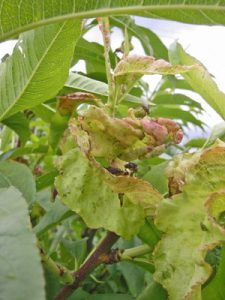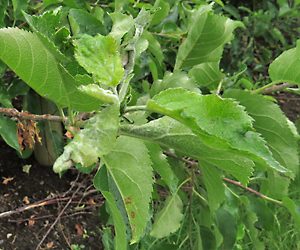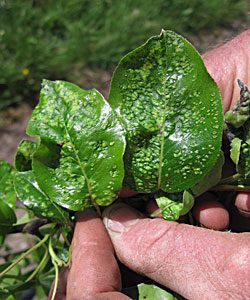In so many ways, 2020 has been a crazy wild ride for everyone. In addition to the world wide pandemic throwing us into chaos, Mother Nature and the weather are also keeping the home orchardist on their toes! A mild February was followed by a March that had both unseasonably warm and unseasonably cold weather, then a very frosty April. May has also had both warm and cold spells, and we’re having a wetter spring than we’ve had in the past few years. The result? Fruit trees that are just a bit more stressed than usual. What we’ve been seeing, and hearing about from customers:

Leaves distorted by peach leaf curl fungus
Peaches- even established leaf-curl resistant varieties- are showing a lot of peach leaf curl this spring. Here at the farm, our non-curl resistant varieties, who had their normal spray program that is usually quite effective, also have significant curl. The only course is to support the trees through this season, removing the worst of the damaged leaves, making sure nutrition and water are adequate this summer, and keeping the fruit load light. “What fruit” you ask? Some peach trees that are in areas particularly hit with those April frosts might not have any fruit at all.
Plums, especially Japanese plums, also have no fruit or very light crops in many areas, also due to frost. Young trees sometimes even have bud damage and are not leafing out normally due to April’s weather. Again, support the trees this summer with water and nutrition, and take a year off canning plums…. For plum and cherry trees that did set fruit, brown rot seems to be a big issue this spring, due mostly to the fluctuating wet/cold, warm/dry weather. This disease causes both blossom blight (blossoms that turn brown and drop before being pollenized) and brown rot in the developing fruit. Sanitation in the orchard is key, removing affected fruit. Bacillus subtilis based sprays (Serenade) can help.
Apples seem to also be light on fruit set in much of the county this year. Worse, powdery mildew is rampant, brought on by the hot-cold alternating weather plus lots of moisture.

Powdery Mildew on apple terminal.
In the home orchard, severely affected terminal shoots can be pruned back. During active growth, organic sprays include potassium bicarbonate based sprays (Monterey Bi-Carb Old-Fashioned Fungicide, Kaligreen, Mil-Stop) , Bacillus amyloliquefaciens based sprays (Monterey Complete Disease Control), and Bacillus subtilis based sprays (Serenade) can help. Horticultural oils can also be used if temperatures remain cool (below 80°F, as can sulfur based sprays (can cause russetting). Do not combine oil and sulfur for trees at this point. Pears can also be infected with powdery mildew in a year like this.

Leaf with pear blister mite
Recently, many people are seeing pear trees with pear blister mite. This tiny mite lives between the leaf surfaces on pear trees, so no sprays are effective during the growing season. This is one of those pests that is easy to control if you spray at the right time (during dormancy), but it’s easy to forget to do it! The adult females overwinter in the dormant bud scales, emerging as the tree breaks dormancy the following spring. Oil plus sulfur, sprayed after leaf fall and again as the buds swell will keep next years leaves from being infested.
And now, it’s time to start tracking heat units for codling moth! Right now, using weather data from the Bellingham Airport, we’re looking at hitting the 525 Degree Days target (most effective spray timing) around June 20 for those who spray for the pest. But the moths are flying sooner than that, and with night time temperatures staying above 50°F, they could start laying sooner. If you’re out thinning your trees (and only have a few trees) consider applying super maggot barriers as you thin. These heavier maggot barriers are more effective against codling moth than the regular weight maggot barriers. If you have had little codling moth in the past, but have had apple maggot, putting on the regular weight maggot barriers during thinning is advised. If you are monitoring for apple maggot in preparation for spraying, have your sticky traps out by mid to late June.

